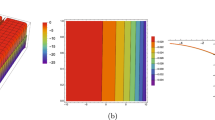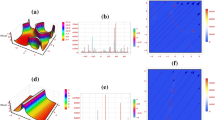Abstract
A technique for analyzing dispersion properties of numerical schemes is proposed. The method is able to deal with both non dispersive or dispersive waves, i.e. waves for which the phase speed varies with wavenumber. It can be applied to unstructured grids and to finite domains with or without periodic boundary conditions.
We consider the discrete version L of a linear differential operator ℒ. An eigenvalue analysis of L gives eigenfunctions and eigenvalues (l i ,λ i ). The spatially resolved modes are found out using a standard a posteriori error estimation procedure applied to eigenmodes. Resolved eigenfunctions l i ’s are used to determine numerical wavenumbers k i ’s. Eigenvalues’ imaginary parts are the wave frequencies ω i and a discrete dispersion relation ω i =f(k i ) is constructed and compared with the exact dispersion relation of the continuous operator ℒ. Real parts of eigenvalues λ i ’s allow to compute dissipation errors of the scheme for each given class of wave.
The method is applied to the discontinuous Galerkin discretization of shallow water equations in a rotating framework with a variable Coriolis force. Such a model exhibits three families of dispersive waves, including the slow Rossby waves that are usually difficult to analyze. In this paper, we present dissipation and dispersion errors for Rossby, Poincaré and Kelvin waves. We exhibit the strong superconvergence of numerical wave numbers issued of discontinuous Galerkin discretizations for all families of waves. In particular, the theoretical superconvergent rates, demonstrated for a one dimensional linear transport equation, for dissipation and dispersion errors are obtained in this two dimensional model with a variable Coriolis parameter for the Kelvin and Poincaré waves.
Similar content being viewed by others
References
Adjerid, S., Devine, K.D., Flaherty, J.E., Krivodonova, L.: A posteriori error estimation for discontinuous Galerkin solutions of hyperbolic problems. Comput. Methods Appl. Mech. Eng. 191, 1097–1112 (2002)
Ainsworth, M.: Dispersive and dissipative behavior of high order Discontinuous Galerkin finite element methods. J. Comput. Phys. 198(1), 106–130 (2004)
Bassi, F., Rebay, S.: A high-order accurate discontinuous finite element method for the numerical solution of the compressible navier-stokes equations. J. Comput. Phys. 130, 267–279 (1997)
Bassi, F., Rebay, S.: A high-order accurate discontinuous finite element solution of the 2D Euler equations. J. Comput. Phys. 138, 251–285 (1997)
Beckers, J.-M., Deleersnijder, E.: Stability of a FBTCS scheme applied to the propagation of shallow-water inertia-gravity waves on various space grids. J. Comput. Phys. 108, 95–104 (1993)
Bernard, P.-E., Chevaugeon, N., Legat, V., Deleersnijder, E., Remacle, J.-F.: High-order h-adaptive discontinuous Galerkin methods for ocean modeling. Ocean Dyn. 57, 109–121 (2007)
Chevaugeon, N., Remacle, J.-F., Galler, X., Ploumans, P., Caro, S.: Efficient discontinuous Galerkin methods for solving acoustic problems. In: 11th AIAA/CEAS Aeroacoustics Conference (2005)
Cockburn, B., Karniadakis, G.E., Shu, C.-W.: Discontinuous Galerkin Methods. Lecture Notes in Computational Science and Engineering. Springer, Berlin (2000)
Gavrilov, M.B., Tosic, I.A.: Propagation of the Rossby waves on two dimensional rectangular grids. Meteorol. Atmospheric Phys. 68, 119–125 (1998)
Gottlieb, D., Hesthaven, J.: Spectral methods for hyperbolic problems. J. Comput. Appl. Math. 128, 83–131 (2001)
Hanert, E., Le Roux, D.Y., Legat, V., Deleersnijder, E.: Advection schemes for unstructured grid ocean modelling. Ocean Model. 7, 39–58 (2004)
Hu, F., Atkins, H.: Eigensolution analysis of the discontinuous Galerkin method with nonuniform grids I. One space dimension. J. Comput. Phys. 182(2), 516–545 (2002)
Ihlenburg, F., Babuška, I.: Finite element solution of the Helmholtz equation with high wave number. Part 2. The h–p version of the finite element method. SIAM J. Numer. Anal. 34, 315–358 (1997)
Iskandarani, M., Haidvogel, D.B., Boyd, J.P.: A staggered spectral element model with application to the oceanic shallow water equations. Int. J. Numer. Methods Fluids 20, 393–414 (1995)
Longuet-Higgins, M.S.: Planetary waves on a rotating sphere II. Proc. R. Soc. Lond. 284, 40–68 (1965)
Majda, A.: Introduction to PDE’s and Waves for the Atmosphere and Ocean. American Mathematical Society (2003)
Marchandise, E., Chevaugeon, N., Remacle, J.-F.: Spatial and spectral superconvergence of discontinuous Galerkin method for hyperbolic problems. J. Comput. Appl. Math. (2006, in press)
Mesinger, F., Arakawa, A.: Numerical methods used in atmospheric models. Glob. Atmospheric Res. Programme (GARP) Publications Series No.17(1) (1976)
Pietrzak, J., Deleersnijder, E., Schroeter, J. (eds.): Ocean Model. (special issue) 10, 1–252 (2005). The Second International Workshop on Unstructured Mesh Numerical Modelling of Coastal, Shelf and Ocean Flows (Delft, the Netherlands, September 23–25, 2003)
Remacle, J.-F., Li, X., Shephard, M.S., Flaherty, J.E.: Anisotropic adaptive simulation of transient flows using discontinuous Galerkin methods. Int. J. Numer. Methods Eng. 62(7), 899–923 (2005)
Thompson, L., Pinsky, P.: Complex wavenumber Fourier analysis of the p-version finite element method. Comput. Mech. 13, 255–275 (1994)
Warburton, T., Karniadakis, G.E.: A discontinuous Galerkin method for the viscous MHD equations. J. Comput. Phys. 152, 608–641 (1999)
Wentzel, G.: A generalization of quantum conditions for the purposes of wave mechanics. Z. Phys. 38, 518 (1926)
Author information
Authors and Affiliations
Corresponding author
Rights and permissions
About this article
Cite this article
Bernard, PE., Deleersnijder, E., Legat, V. et al. Dispersion Analysis of Discontinuous Galerkin Schemes Applied to Poincaré, Kelvin and Rossby Waves. J Sci Comput 34, 26–47 (2008). https://doi.org/10.1007/s10915-007-9156-6
Received:
Revised:
Accepted:
Published:
Issue Date:
DOI: https://doi.org/10.1007/s10915-007-9156-6




